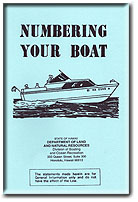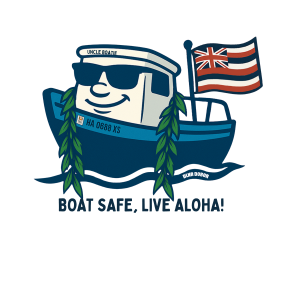Numbering Your Vessel
 WHY REGISTRATION AND PROPER NUMBERING IS IMPORTANT
WHY REGISTRATION AND PROPER NUMBERING IS IMPORTANT
All undocumented vessels, with few exceptions, must be registered with DOBOR, which assigns a unique registration number to each vessel. This number is used for search and rescue, safety control, and theft prevention. Boat owners affix the registration number on each side of the hull in a manner to ensure that it is legible.
Proper number display is the sole responsibility of both the boat owner and the boat operator.
EXCEPTIONS TO REGISTRATION
Exceptions to the registration requirement include boats that are manually propelled, eight (8) feet or less in length and propelled solely by sail, certain public vessels, documented (federally registered) vessels, foreign vessels, vessels from another State in Hawaii’s waters for 60 days or less, a ship’s lifeboats used solely for lifesaving purposes, and any motorized vessel whose propulsion machinery produces less than five (5) horsepower. Owners of undocumented vessels vessel may apply for a registration number even if the boat is exempt from Hawaii’s numbering requirements.
WHERE TO TITLE, REGISTER, AND RENEW; FEES
Boaters may title, register, and transfer ownership of their vessel at any DOBOR District Office and at the DOBOR Administrative Office in Honolulu. The titling fee is a fixed rate. Registration fees are based on a vessel’s length. A registration is valid for one year and may be renewed in advance up to 90 days preceding the expiration date. More information on vessel registration and titling fees is available here.
PROOF OF OWNERSHIP REQUIRED TO OBTAIN VESSEL NUMBER
Proof of ownership must be provided before a person can receive a number for their vessel. For newly purchased vessels, the owner must provide a valid Manufacturer’s Statement of Origin (also known as a Manufacturer’s Certificate of Origin). For all other vessels, a properly endorsed Hawaii vessel title, out-of-state vessel title, or other applicable out-of-state document(s) must be provided to transfer ownership. If neither of the aforementioned is available, DOBOR staff will work with a person to determine what paperwork is needed to complete a transfer.
NOTICE MUST BE GIVEN IF REGISTRATION IS LOST, MUTILATED, OR STOLEN
If a registration card is stolen, lost, or mutilated, the owner must notify DOBOR within seven (7) days. The owner may apply for a replacement title and/or registration. Fees for duplicates will apply. DOBOR must also be notified if there is a change in address of the owner(s), the vessel is abandoned, the vessel is a total loss or it is destroyed, if all interest or part interest in a vessel is transferred to another person or entity, if the vessel is permanently removed from the State, or the vessel becomes documented by the USCG. If your vessel is stolen, call the police immediately. A stolen vessel report must be filed with DOBOR.
HULL IDENTIFICATION NUMBER (HIN)
A manufacturer-issued HIN is used on vessel documents and consists of a combination of 12 numbers and letters. The HINs for vessels manufactured before 1972 may not conform to the 12-character requirement. After January 1, 1967, no vessel may be sold or offered for sale in Hawaii unless it has a valid 12-character HIN. If the HIN on a vessel has been removed, obliterated, or if the vessel is homebuilt, DOBOR will assign it a permanent HIN. Intentional removal or defacing of the manufacturer’s HIN on a vessel is a criminal offense.
VESSEL NUMBERING REQUIREMENTS
- A vessel’s number must be painted on or permanently attached to each side of the forward half of the vessel and must be read from left to right. The number shall not be placed on the obscure underside of a flared bow where the angle prevents it from being seen from another vessel or from the shore.
- The four numerals appearing between letters must be separated by hyphens or spaces equal to the width of any letter except “I”.
- Registration decals, which show valid registration, must be placed on each side of the vessel three (3) inches aft of the number and directly in line with it.
- Numbers and letters must be at least three (3) inches in height and of block character.
- Numbers must be of a color which will contrast with the color of the background.
- Numbers must be maintained so as to be clearly visible and legible at a distance of at least one hundred (100) feet.
- No other numerals, letters, or devices may be placed near the vessel number.
RECOMMENDATIONS FOR EFFECTIVE DISPLAY OF NUMBERS
- Disregard outlining or shading in determining height or color contrast. Use letters and numbers of a solid color.
- Avoid shaded numbers. Slanted or script numbers do not meet U.S Coast Guard standards.
- Use colors that furnish the greatest contrast between numbers and background. The best results are achieved by a very dark color on a light background, or vice versa.
- When a backing plate of a different color than the hull is used, be certain that the plate extends far enough beyond the number to provide sufficient background for contrast.
HINTS FOR NUMBER AND DECAL MAINTENANCE
- Registration numbers and decals should always be applied to a clean, dry surface and pressed firmly in place.
- To help secure the numbers and decals, a clear spray coating may be used to cover them.
- Protection of numbers and decals may become a problem when refinishing your boat. These methods may help address this problem:
- Mount the numbers and decals on a removable backing plate. The backing plate can be secured to the hull and removed as necessary.
- Numbers and decals may be removed by applying sufficient heat to loosen the adhesive, and reapplied with marine-type glue if not damaged. The chances of damaging the numbers and decals are HIGH regardless of method of removal.
- Paint around the numbers and decals carefully. If masking tape is used to cover them, it should be removed as soon after painting as possible.
- If paint gets on the numbers and decals, care should be used in removing it. Some materials, such as carbon tetrachloride, paint remover, or paint thinner will deface the numbers and decals, especially if applied with a hard rubbing motion.
This page was last updated on 8/12/21.
